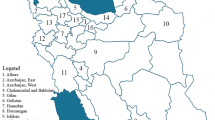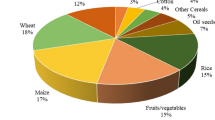Abstract
This article describes a study of the environmental impacts of the use of industrial agricultural chemicals in four Asian countries—China, India, the Philippines and Thailand. The objective was to contribute objectively to the discussion on the extent of the problem, past and current damages to the environment to and outline possible paths to sustainable and environmentally benign agriculture. The four countries are experiencing rapid economic growth under a tremendous population growth pressure that, with the exception of China, will continue without leveling of in a foreseeable future. This requires more food production that has been accomplished by the increased use of industrial chemical fertilizers. Although the four countries uses of industrial chemicals vary, the mix of nutrients appears to be imbalanced, resulting in large nitrogen losses into the environment, especially in China. A suggested solution of the problem begins with reducing (China) or maintaining (India, the Philippines, Thailand) average nutrient application levels needed by the crops and includes optimal hybrid agriculture by using organic fertilizers, and fertilizers in the irrigation water already overloaded with nitrogen. There is a need to balance fertilizer N and P applications with the crop needs.







Similar content being viewed by others
References
ActionBioscience. (2002). Biotechnology and the Green Revolution, Interview with Norman Borlaug. American Inst. Biological Sciences. http://www.actionbioscience.org/biotech/borlaug.html.
Agrawal, G. D. (1999). Diffuse agricultural water pollution in India. Water science and technology, 39(3), 33–47.
Agrawal, G. D., & Trivedi, R. C. (2001). “Management of diffuse water-pollution in developing counties—Goals and policies” key note address. Milwaukee, WI: IWA Conference on Diffuse pollution and Watershed Management.
Barboza D (2009). Economy in China regains robust pace of growth. New York Times.
Barnard, J. L. (2007). Elimination of eutrophication through resource recovery, The 2007 Clarke Lecture. Fountain Valley, CA: National Water Research Institute.
Bendorichio, G and Jorgensen, S. E. (2000). An Eco-system approach for a sustainable management of Laguna-de-Bay, Philippines. Scientific Workshop on Diffuse Pollution in Sub-Tropical and Tropical Developing Countries and its Abatement, Bangkok, Thailand.
Blackman, A. (2000) Obstacles to a Doubly Green Revolutions, Discussion Paper 00-48, Resources for the Future, Washington, DC (http://www.rff.org/Documents/RFP-DP-08-48.pdf).
Bouman, B. A. R., Castañeda, A. R., & Bhuiyam, S. I. (2002). Nitrate and pesticides contamination of groundwater under rice-based cropping systems: Past and current evidence from The Philippines. Agricultural Ecosystems and Environment, 92, 185–199.
Brundtland, G. H., et al. (1987). Our common future. The World Commission on Environment and Development. Oxford: Oxford University Press.
CCICED. (2004). Policy Recommendations to reduce Non-point Pollution from Crop production in China—The English Version. China Council for International. Cooperation on Environment and Development, Beijing, http://www.cciced.org/cn/company/TMxxb143/card143.asp?lmid=5219&siteid=1&tmid=2414&flbh=143.
Conway, G. (1997). The doubly green revolution: Food for all in the 21st Century. London: Penguin Books.
Eghball, B., & Power, J. F. (1999). Phosphorus- and nitrogen-based manure and compost applications: Corn production and soil phosphorus. Soil Science Society of America Journal, 63, 895–901.
FAO (2006) Global forest resources assessment 2005, Progress towards sustainable forest management, food and agriculture organization of the United Nations, Forestry Paper 147, Rome.
FAO (2008) The State of Food Insecurity in the World 2008. High food prices and food security—Threats and opportunities. Food and Agriculture Organization of the United Nations. http://www.fao.org/SOF/sofi/index_en.htm.
Fisher, G., Chen, Y., & Sun, L. (1998) The Balance of Cultivated Land in China during 1988–1995, International Institute for Applied System Analysis, IR–98–047, Laxenburg, Austria.
Iital, A., Stålnacke, P., Deelstra, J., Loigu, E., & Pihlak, M. (2005). Effect of large-scale changes in emissions on nutrient concentrations in Estonian Rivers in Lake Peipsi drainage basin. Journal of Hydrology, 304(1–4), 261–273.
International Rice Research Institute. (2007). http://www.irri.org/science/ricestat/index.asp.
IPCC (2007). Summary for policy makers, climate change 2007: The physical scientific basis, fourth assessment report, intergovernmental panel on climatic change, Working Group (WG 1), Geneva.
IPNI. (2007). Organic agriculture impact on the food quality and the environment: A china perspectives. International Plant Nutrition Institute, Norcross, GA, http://www.ppi-ppic.org/ppiweb/sechina.nsf/$webindex/A1D6ADA378E165F548256C620031BF9E?opendocument&navigator=home+page.
Liu, J., et al. (2005). Spatial and temporal patterns of China’s cropland during 1990–2000: An analysis based on Landsat TM data. Remote Senses & Environment, 98(4), 442–456.
Majudmar, D., & Gupta, N. (2000). Nitrate groundwater pollution and associated human health disorders. Indian Journal of Environmental Health, 42(1), 28–39.
Matson, P. A., Neylor, R., & Otis-Monasterio, I. (1998). Integration of environmental, agronomic, and economic aspects of fertilizer management. Science, 280, 112–115.
Matson, P. A., Parton, W. J., Power, A. G., & Swift, M. J. (1997). Agricultural intensification and ecosystem properties. Science, 277, 504–509.
Meyer, W. B., & Turner, B. L., I. I. (1992). Human population growth and global land-use/cover change. Annual Review of Ecology and Systematics, 23, 39–61.
National Bureau of Statistics of China. (2006). China statistics yearbook—2006. Beijing: China Statistics Press.
Novotny, V. (2003). Water quality – diffuse pollution and watershed management. Hoboken, NJ: John Wiley Publication.
Novotny, V. (2007). Diffuse pollution from agriculture: Ecological sustainability or food production or both. Water 21 (IWA), 52–59.
Novotny, V. (2009). Cyanobacteria blooms and hypertrophy in reservoirs with a focus on the Želivka River (in English). Water Management (Vodni Hospodarstvi), 2009, 171–179.
Novotny, V., Englande, A. J., Wang, X., Bedoya, D., Promakasokorn, L., Huang, X., et al. (2007). Use of agricultural chemicals in China, India, The Philippines, and Thailand and their environmental and environmental impacts. University of Exeter, UK: Draft report submitted to Greenpeace Laboratory.
OECD (2008) Environmental Performance of Agriculture in OECD countries since 1990, Paris, France, www.oecd.org/tad/env/indicators.
Pathak, H., Li, C., Wassmann, R., & Ladha, J. K. (2006). Simulation of nitrogen balance in rice–wheat systems of the Indo-Gangetic Plains. Soil Science Society of America Journal, 70, 1612–1622.
Postel, S. (2001). Growing more food with less water. Scientific American, 284(2), 46–50.
Rosset, P., Collinds, J. & Moore-Lappe, F. (2000). Lessons from the green revolution, food first. Institute for Food and Development Policy, http://www/foodfirst.org/media/opeds/4-grrrre.html.
Salomons, W., & Stol, B. (1995). Soil pollution and its mitigation: Impact of land use changes on soil storage of pollutants. Lancaster, PA: TECHNOMIC Publishing Co.
Scharf, P. C., Kitchen, N. R., Sudduth, K. A., Davis, J. G., Hubbard, V. C., & Lory, J. A. (2005). Nitrogen management—Field—Scale variability in optimal nitrogen fertilizer rate for corn. Journal of Agronomy, 97, 452–461.
Simachaya, W. (2002) Water quality monitoring and modeling application in Thailand. Paper prepared for the third world water forum session “water quality monitoring and modeling- the present situation and partnership in the future” October 16–17, 2002 at the United Nation University Center in Tokyo, Japan.
Singh, B., & Sekhon, G. S. (1976). Nitrate pollution of groundwater from nitrogen fertilizers and animal wastes in the Punjab. Agriculture and Environment, 3, 57–67.
Singh, K. P., Singh, V. K., Malik, A., & Basant, N. (2006). Distribution of nitrogen species in groundwater aquifers of an industrial area in alluvial Indo-Gangetic Plains—A case study. Environmental Geochemistry and Health, 28, 473–485.
Smil, V. (1995). Who will feed China? China Quarterly, 143, 801–813.
Smil, V. (2001). Enriching the earth: Fritz Haber, Carl Bosch and the transformation of world food production. Cambridge, MA: MIT Press.
Stålnacke, P., Grimwall, A., Libiseller, C., Laznik, M., & Kokorite, I. (2003). Trends in nutrient concentrations in Latvian rivers and the response to the dramatic change in agriculture. Journal of Hydrology, 283, 184–205.
Tilman, D., Cassman, K. G., Matson, P. M., Naylor, R., & Polasky, S. (2002). Review article: Agricultural sustainability and intensive production practices. Nature, 418, 671–677.
Tirado, R. (2007). Nitrates in drinking water in Philippines and Thailand. Technical Note 11/2007. Greenpeace Research Laboratories, University of Exeter (UK), http://greenpeace.to/publications/Nitrates_Philipines_Thailand.pdf.
US Geological Survey. (1999). The quality of our nation’s waters. Circular 1225, USGS, Reston, VA.
Williams, J. (2005). Understanding the overuse of chemical fertilizers in China- a synthesis of historic trends, recent studies, and field experiences. http://forestry.msu.edu/China/New%20Folder/Jo_Fertilizer.pdf.
Zhu, Z., Sun, B., Yang, L., & Zhang, L. (2005). Policy and countermeasures to control non-point pollution of agriculture in China. Science & Technology Review, 23(4), 47–51. in Chinese.
Acknowledgments
The authors thank Greenpeace International for sponsoring the initial study on which this paper is based. The authors also thank two anonymous reviewers for their time and advice. The findings expressed in this paper are solely those of the authors.
Author information
Authors and Affiliations
Corresponding author
Additional information
Readers should send their comments on this paper to BhaskarNath@aol.com within 3 months of publication of this issue.
Rights and permissions
About this article
Cite this article
Novotny, V., Wang, X., Englande, A.J. et al. Comparative assessment of pollution by the use of industrial agricultural fertilizers in four rapidly developing Asian countries. Environ Dev Sustain 12, 491–509 (2010). https://doi.org/10.1007/s10668-009-9207-2
Received:
Accepted:
Published:
Issue Date:
DOI: https://doi.org/10.1007/s10668-009-9207-2




